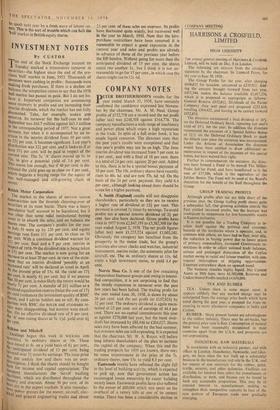THE SELECTIVE BOOM
By NICHOLAS DAVENPORT IF there is still a cycle in business affairs,' Mr. Amory told the Insti- tute of Directors at their annual conference on October 30, 'it is very different from what it used to be. The alternates then were boom and slump. Nowadays we are either expanding or checking expansion to avoid inflation and that's a very different story.' Nevertheless, I still believe in the efficacy of what is known as 'the cyclical investment policy' and have no doubt that it is still correct to be buying British equity shares, the market in which has now broken through its old 1955 peak. But I cannot warn the in- experienced investor too often that he must be- come more and more selective as the boom goes on. No recovery is ever evenly spread.
On this page we have so.far favoured for invest- ment only the prosperous consumer goods trades and I am interested to see from the Investors Chronicle indices of share prices that as com- pared with the end of June, 1955—the peak of the previous bull market—the equities of retail stores, radio, provisions and brewery companies are 28 per cent. higher today, while those of silk and rayon are 43 per cent. below and of electrical equipment nearly 30 per cent. below. It has been a very 'choosey' bull movement, although the industrial share average is a third higher today than it was at the end of February.
This is not intended to suggest that the time has come to look at the comparatively depressed trades. The Financial Times has just given the results of company profits published over the first ten months of the year. The total is still up but the growth is slackening fast and in the past four months equity earnings as a whole are actually 2 per cent. down. The motor group leads with an 18 per cent. rise in profits, but wool textile profits are down by as much as 50 per cent. Present market trends seem likely to continue—with the growth confined to the purely domestic trades which the Chancellor has recently been favouring.
It is reassuring to have Mr. Amory, the father of this boom, so confident of the trade outlook, but I am taking his words with a pinch of salt. He told the National Production Advisory Coun- cil last week that the current unemployment prob- lem was a relatively short-term one and that the effect of the recent government measures would be quite marked. But a recovery in our consumer durable goods does not necessarily spill over into the export trades; an increased domestic demand for steel for the motor and building industries does not improve the demand for steel plate in the ship- building industry. Labour merely flows from the contracting to the expanding trades and transi- tional unemployment remains high. The Minister of Labour expects unemployment to reach about 2.8 per cent. of the labour force by January or February, 1959—well over 600,000—before the seasonal fall begins to take effect next spring. Mr. Amory then expects a revival in foreign trade to come to our rescue. I hope he is right but there is a considerable gap before the decisions taken at the Montreal and New Delhi conferences can be translated into loans and credits, and the Chancel- lor's estimate of an export revival may be too sanguine in point of time. Another threat to his calculations is the uncertainty over the European economic scene. If the project for a free trade'area is still-born, as seems inevitable, the starting-up of the common market on January 1, with a 10 per cent. tariff cut inside the common-market enclave, will be a heavy blow to British exporters.
There is another uncertainty which is worrying the professional investor—and perhaps Mr. MVO' too. This is the labour reaction to recovery. It is not a question of re-expansion bringing back inflation through pressure of demand in the labour market. The huge amount of industrial investment which has been carried through in recent years must have resulted in a more economical use of labour. A recent survey of the metal-using industries by the National Institute of Economic and Social Re- search brought out that if demand were adequate, about 80 per cent. of the firms interviewed could raise their output by 10 per cent, or more with only a modest intake of labour and with an actual fall in costs per unit of output. There is therefore very little chance of Mr. Ainory's reflation bringing back the old type of pressure in the labour market, in- crease what will undoubtedly follow from the n crease in company profits in the expanding trades is a demand from the trade unions for a share in it. Prices may remain stable, and there may be e° justification for any rise in wages to, keep Pace, with a rise in the cost of living, but the sight (/' rising profits will surely excite the envy of Ihf. workers. How will the Government deal with slic" a situation? How will it answer a demand for a „ per cent. rise in wages to match a 10 per cent. roe in profits? It is significantly enough taking steps to prevent an award of higher wages in the Pr()s,, perous trades going the union rounds thrall," the compulsory arbitration machiniry. This will arouse a great storm in the. House of Com- mons and it may be that our happy recovery Will be spoilt next year by a fresh wave of labour un- !est. This is the sort of trouble which can halt the bull' market in British equity shares.







































 Previous page
Previous page